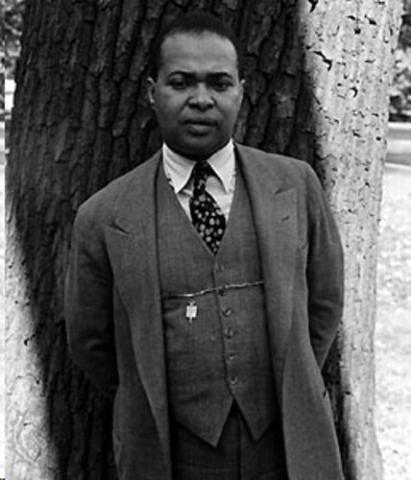

Queer Places:
2190 7th Ave, New York, NY 10027
DeWitt Clinton High School, 100 W Mosholu Pkwy S, Bronx, NY 10468, Stati Uniti
New York University, New York, 10003, Stati Uniti
Harvard University (Ivy League), 2 Kirkland St, Cambridge, MA 02138
Woodlawn Cemetery, E 233rd St & Webster Avenue, Bronx, NY 10470, Stati Uniti
 Countee Cullen (May 30, 1903 – January 9, 1946), born Countee LeRoy Porter,
was a prominent African-American poet, novelist, children's writer, and
playwright during the Harlem Renaissance.[1]
A number of Harlem Renaissance writers, including
Wallace Thurman,
Claude McKay,
Countee Cullen, and possibly
Langston Hughes, had
relationships with men, and the writing of this genre often included
references to homosexual life. McKay’s 1928 Home to Harlem included a scene
where “the dark dandies were loving up their pansies”; Thurman’s The Blacker
the Berry (1929) and The Infants of the Spring (1932) also referenced this
world.
Countee Cullen (May 30, 1903 – January 9, 1946), born Countee LeRoy Porter,
was a prominent African-American poet, novelist, children's writer, and
playwright during the Harlem Renaissance.[1]
A number of Harlem Renaissance writers, including
Wallace Thurman,
Claude McKay,
Countee Cullen, and possibly
Langston Hughes, had
relationships with men, and the writing of this genre often included
references to homosexual life. McKay’s 1928 Home to Harlem included a scene
where “the dark dandies were loving up their pansies”; Thurman’s The Blacker
the Berry (1929) and The Infants of the Spring (1932) also referenced this
world.
Cullen was first brought to the idea of his sexuality from the help of American writer Alain Locke. Locke wanted to introduce a new generation of African American writers, like Countee Cullen. Locke sought to present the authentic natures of sex and sexuality through writing, thus creating relationships with those that felt the same. Locke helped Cullen accept his sexuality, exposing him to gay-affirming material, like the work of Edward Carpenter. In March 1923, Cullen had written in a letter to Locke: "It opened up for me soul windows which had been closed; it threw a noble and evident light on what I had begun to believe, because of what the world believes, ignoble and unnatural".[14]
Cullen married Yolande Du Bois on April 9, 1928, the only surviving child of W.E.B. Du Bois.[15] It is said that they were introduced by Cullen’s close friend Harold Jackman.[16] Cullen and Yolande met in the summer of 1923 when Yolande was attending Fisk University and Cullen was enrolled at New York University.[17] Cullen’s parents owned a summer home in Pleasantville, New Jersey and Yolande and her family were likely vacationing in the Pleasantville area when they they first met.[17] While at Fisk University, Yolande had a romantic relationship with jazz musician, Jimmie Lunceford.[18] However, her father disapproved of Jimmie and the relationship ended when Yolande accepted her father’s wishes of a marriage to Cullen.[18] The wedding was the social event of the decade. Cullen, along with W.E.B. Du Bois planned the details of the wedding with little input from Yolande.[15] Every detail of the wedding, including the rail car used for transportation and Cullen receiving the marriage license four days prior to the wedding day, was considered big news and was published to the public by the African American press.[15] On the day of the wedding, the church was overcrowded being that 3,000 people came to witness the ceremony.[15] After the newly wedded couple had a short honeymoon, Yolande did not join Cullen on a trip to Paris with his father and best man, Harold Jackson.[19] A few months after their wedding, Cullen had written a letter to Yolande confessing his love for men.[20] W.E.B. Du Bois wrote a letter to Cullen where he expressed his belief that Yolande’s lack of sexual experience was the reason the marriage did not work out.[21] The couple then divorced in 1930 and was negotiated between Cullen and W.E.B. Du Bois.[15][22]
Elmer Holmes Bobst Library, 70 Washington Square S, New York, NY 10012
Divorcing Yolande, Countee Cullen remarried in 1940 and stayed with his wife Ida Robertson while being involved in a long - lasting secret relationship with the younger Edward Atkinson.
With an exception to his first marriage, Cullen was a shy person and was not flamboyant with any of his relationships.[20] It was rumored that Cullen developed a relationship with Harold Jackman, "the handsomest man in Harlem", which contributed to Cullen and Du Bois’ divorce.[20] The young, dashing Jackman was a school teacher and, thanks to his noted beauty, a prominent figure among Harlem's gay elite. According to Thomas Wirth, author of Gay Rebel of the Harlem Renaissance, Selections from the Work of Richard Bruce Nugent, there is no concrete proof that they ever were lovers, despite newspaper stories and gossip suggesting the contrary.[20]
Jackman's diaries, letters, and outstanding collections of memorabilia are held in various depositories across the country, such as the Amistad Research Center at Tulane University in New Orleans and Atlanta University (now Clark Atlanta University) in Atlanta, Georgia. At Cullen's death, Jackman requested that the name of the Georgia accumulation be changed from the Harold Jackman Collection to the Countee Cullen Memorial Collection in honor of his friend. When Jackman, himself, succumbed to cancer in 1961, the collection was renamed the Cullen-Jackman Collection to honor them both.[23]
My published books: